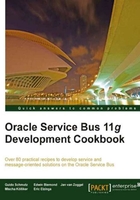
Adding an operational branch to support the different WSDL operations of the proxy service
To support the different operations of the WSDL we need different branches, which will hold the necessary flow logic. This can be achieved with an Operational Branch node.
Getting ready
Make sure you have the current state of the basic-osb-service project available in Eclipse OEPE. We will start this recipe from there. Delete the existing routing node by right-clicking on it and then select Delete. We again have an empty message flow to start with. If needed, it can be imported from here: \chapter-1\getting-ready\echo-proxy-service-created.
How to do it...
- Drag an Operational Branch node from the Design Palette on the right and drop on the Message Flow below the interface.
- Change the name of the Operational Branch node to HandleOperationBranch, by editing the Name field in the property window.
- The branch node contains two branches, one for the operation FindCustomer and the Default branch. We need one more branch for the StoreCustomer operation.
- Click on the + symbol in the upper-right corner of the operation branch and a new branch is added and selected:

- Navigate to the Properties tab of the new branch and change the Operation in the drop-down list to StoreCustomer.
- Drag a Route node from the Design Palette and drop it on the FindCustomer branch.
- Drag another Route node from the Design Palette and drop it on the StoreCustomer branch.
- Rename the Route nodes to FindCustomerRoute and StoreCustomerRoute.
- Drag a Routing Action from the Communication section of the Design Palette to both Route nodes:

- In the Properties of the Routing action, inside the FindCustomerRoute, click on Browse next to the Service field and select the business service CustomerService.biz (to be found in the
businessfolder). - In the Invoking drop-down list, select RetrieveCustomerByCriteria as the operation to be called.
- Repeat steps 8-10 for the Routing action of the StoreCustomerRoute, but this time select the CreateNewCustomer in the Invoking drop-down list.
- Click on the Save button.
How it works...
The operational branch allows for implementing each operation of a multi-operational WSDL in a different way. In the Message Flow that we have implemented so far, the difference was just the routing to another operation on the external service. If the WSDL only contains one operation, then an operational branch is not really necessary. But we suggest to always use it from the beginning, in order to be prepared if an additional operation is added later. This also provides an option to handle invalid invocations or unsupported operations in the default branch.
With that in place, the service will now correctly route the calls on the different operations. What is not yet done is the adaption between the data models of the two services. This will be covered in the next recipe.
There's more...
In this section, we will discuss the default branch of an Operational Branch node and show how to handle an operation which is not (yet) supported.
Each single operation does not need to have its own branch. If an operation has no branch, then a call on that operation will end up in the default branch and all calls to an operation without a dedicated branch have to be handled there. If the default handler is left empty, then the behaviour will be an echo, similar to the empty proxy service that we have seen a few recipes back. So every message sent on an operation without a branch will be sent back untouched and unchanged.
The default branch can be used to either generically handle all other messages not handled by a specific branch or to return an error, that this operation is not (yet) supported (see next section).
Use the default branch to raise an error by performing the following steps:
- Drag a Pipeline Pair node from the palette and drop it on the Default branch flow.
- Rename the pipeline pair to HandleUnsupportedOpsPipelinePair.
- Drag a Stage node from the pallet and drop it on the Request Pipeline flow.
- Drag a Raise Error action from the design palette and drop it into the stage flow.
- Enter the error-code into the Code field and a meaningful error message into the Message field:

An operation branch should not be left empty just because it will only be implemented later and is not supported with the current release. If a branch is empty, then it will have the 'echo' behavior, resulting in a message sent to such an operation being returned just as is. It might be very difficult for a potential caller of such an operation to find out what happened. It's better to remove the branch completely and let the Default branch handle it or to add a Raise Error to the operational branch to signal an error:

When using a branch specific for each operation, the name of the operation can be specified in the error message. If somebody is using the not yet supported StoreCustomer operation, the following SOAP fault will be returned:

See also
See the next recipe for how to map between the different data models the two services use.